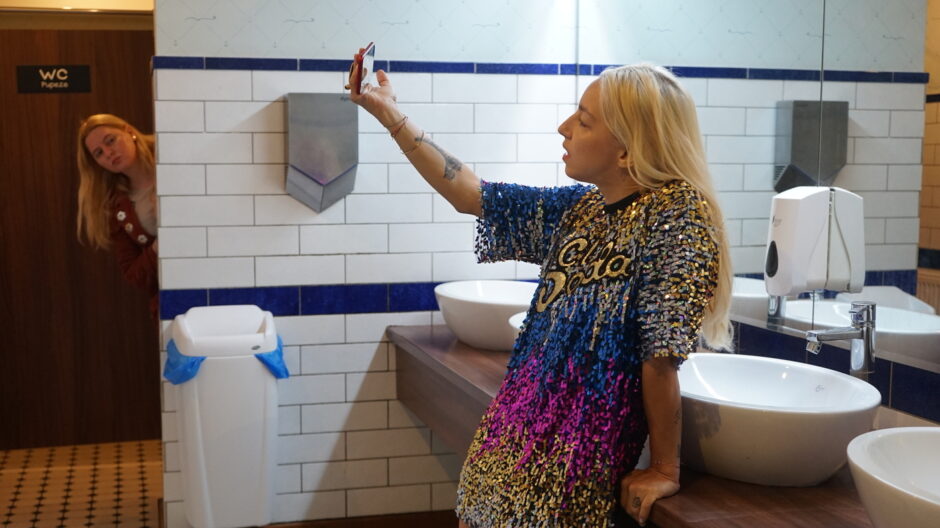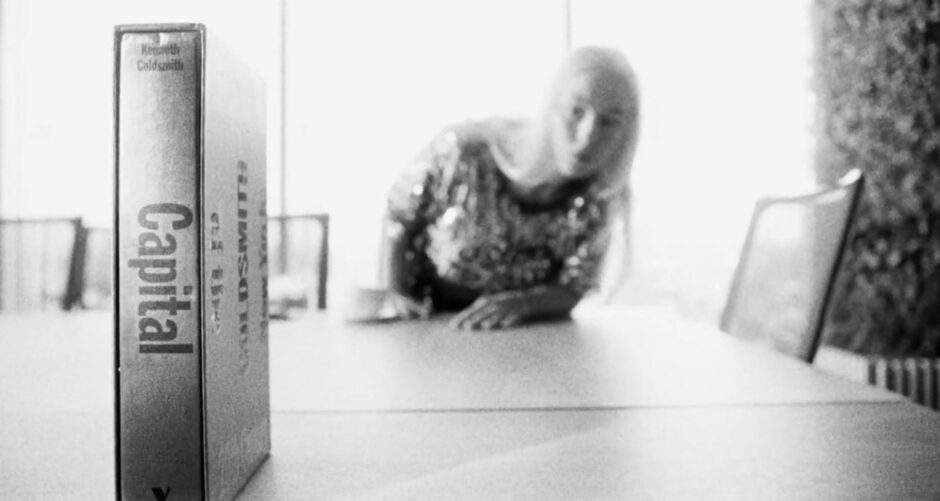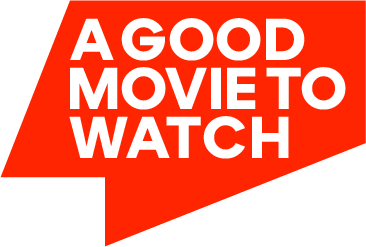Exhausting in a good way, Radu Jude’s Do Not Expect Too Much From the End of the World is a blackly comic incision into a Romania in crisis. The film tracks the laborious, repetitive schedule of a videographer, Angela (Ilinca Manolache), as she records admissions of guilt from factory workers who don’t seem totally liable for their accidents. Jude’s camera cuts from monochrome film stock to digital frames, with CG zoom backgrounds and TikTok-esque face filters interjecting into the film to heighten the disorientation Angela’s day consists of. The comedy is pitch-black and the political commentary is unignorable; Jude has crafted a shrewd, immersive 163-minute takedown of the latest stage of capitalism Europe has seen.
Projektor had the chance to speak to Jude at the Glasgow Film Festival about his commanding film.

Projektor: Central to the film, tonally and thematically, is a sense of exhaustion. How did you want to convey the feeling of exhaustion throughout the film?
Radu Jude: It was a challenge, because exhaustion is not necessarily visible. In a film with limited duration, how do you convey the time that it takes to be overworked? My solution was to give [the film] a bit more length. That way, the exhaustion appears from the character and performance.
When I was just starting out, I went through all the low-paid jobs in the hierarchy of a film crew. I knew some people who died because of the extra hours. There was a camera assistant who died after 48 hours of continuous shooting. Because he was a freelancer, he had several projects that overlapped, one after another.
When I was young, there was legislation that didn’t permit it, but nobody applied it. I think this is the main problem – the laws exist and the laws more or less protect the citizens from certain abuses. But nobody applies them.
Where did the storyline of recording accident liability testimonies come from?
The two main stories and other secondary storylines are all inspired by events I witnessed, or they happened to me one way or another, especially at the beginning of my career. I think it’s interesting to mention that [they’re] a little bit older, because I think that in the years that pass, they became exemplary in a way. They achieved a symbolic quality. We are always in a flux of things happening and you don’t know which is more important than another. Sometimes something huge happens, an event that will mark history – other times, there are smaller things that seem like nothing, but when you look back on them, you can say, this was a sign already.
You’ve mentioned you don’t consider yourself to have a distinct visual style as a filmmaker, which is interesting because there are so many unique visual textures throughout the film. Do you see not having a trademark style as a freedom?
It’s true. At the beginning [of my career], I struggled with the idea that every serious artist should have an array of subjects, topics, or obsessions, and also a consistent style that he or she develops, but I couldn’t find that for me. Later on, however, I came to accept it. I feel freer, in a way, and I don’t even have to be consistent with myself. I’m a curious person. I like whatever comes to my attention and I like to experiment. I feel free to do it.
I want to do more. And by doing more, I think the quantity itself creates a kind of quality. And also maybe it’s connected with age. I’m not that old, but when you’re at the beginning, you have to prove something. You get into this game, even if you want to or not. But after a while, you feel no need to prove anything. That’s another layer of freedom.
“I want to do more. And by doing more, I think the quantity itself creates a kind of quality.”
The film is made up of all these vignettes and isolated scenes from different camera perspectives. What was the shooting schedule like for the film?
I tried to simplify the process. I think we are tricked, nowadays, because the technologies we have now are cheaper and easier, sure, but the cinema industry is never satisfied. It’s always “You have to do more” and I try to do less. For this film, we shot everything without any additional light apart from one scene. We used a 16-millimeter camera, a digital camera, a phone camera, and everything went smoothly. I think we shot everything in 21 days, and we never [needed] extra time, we were always [on] schedule.

The film has an amazing one-shot climax that’s so distinct from the rest of the film – a completely static shot for nearly half an hour. What was the genesis for structuring and shooting it that way?
The genesis was an inability to do it otherwise. When it was still a blueprint, the film was actually built backward. So this last scene was the first, then the archive footage came in. Then I thought about the cast and the avatar, which was created by the actress herself during the pandemic. So the project was built on these layers, one after another.
So this second part, I wanted to be very didactic, in a way. I know that’s a word all serious artists hate, “didactic.” But what I hate is didacticism, not being didactic, [which] I think is okay. Because I wanted to see everything through the camera that records the ad, so I wanted to offer this freedom for the viewer to see.
But also, because this would be like a mockumentary, I wanted to make it more artificial. So then I had this idea to make it like theater, a bad amateur political theater play to give it more distance. The viewer is invited to consider all these things and to see what comes out of it. It’s like a documentary, but at the same time, it’s like theater. It’s very raw, but sometimes the dialogue is very literary. I like contradictions, I think this scene has the most contradictions in the whole movie.

